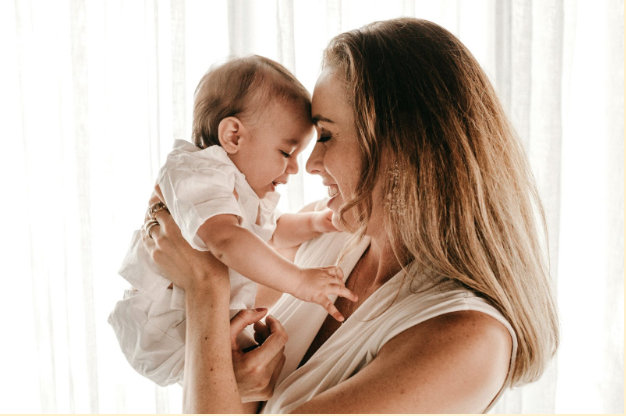A guide to cultivating peace, presence, and financial wellbeing in family life.

Motherhood is a dance between chaos and harmony, a balance we tirelessly seek amidst school runs, meal preps, and the myriad duties that fill our days. In the quest for peace, mindfulness emerges as a beacon of light, promising not just a momentary reprieve but a transformation of our very approach to life’s tumults. Alongside, we glimpse the holistic tapestry of well-being, where threads of financial security intertwine with emotional peace to craft a sanctuary called home.
The Basics of Mindfulness
At its core, mindfulness is about being present. It’s an invitation to experience the here and now with openness and curiosity. Rooted in Buddhist traditions, this ancient practice can still work wonders when applied to our modern lives. It teaches us to observe our thoughts and feelings without judgment but rather in a state of awareness that illuminates our experiences.
Research underscores how mindfulness can be a balm for the mind, alleviating stress, enhancing emotional resilience, and enriching our relationships. For parents, this translates to more patience, empathy, and connections for our families.
Mindfulness can be adapted to every element of your life, from your parenting to your home—and even to your finances.
Mindfulness Techniques for Moms

In motherhood, mindfulness can feel like a lifeline amidst the chaos. It can help you find grace in the tired moments and connection in the midst of routine. Let’s take a look at some mindfulness techniques that can offer a pathway to a serene mind and a harmonious home.
Breathing Exercises
Breathing is the most fundamental of our life’s rhythms. But, how often do we really stop to think about our breathing? Breathing exercises can be a powerful tool for anchoring ourselves in the present. Here are some breathing techniques that can help ground you:
- Square breathing – Visualize drawing a square in your mind. Inhale for four counts, hold the breath for four counts, exhale for four counts, and then hold agan for four counts. This technique can be a quick reset, bringing calm and focus amidst daily turmoil.
- Diaphragmatic breathing – Place one hand on your chest and the other on your belly. Breathe in deeply through the nose, ensuring that the diaphragm (not the chest) inflates with enough air to create a stretch in the lungs. Pause, then exhale slowly. This exercise is especially beneficial for reducing stress levels and improving concentration.
Mindful Meditation
Meditation doesn’t need to be done in solitude or silence, and it doesn’t need to be for long amounts of time either. Guided meditations are a great place to start.
Use a guided meditation app or follow a video during a quiet moment, perhaps before the kids wake up or after they go to sleep. You can find guided meditations that range from anywhere between 5 and 20 minutes and can be a gentle introduction to meditation practices.
You can also integrate mindfulness into family time by doing short meditation sessions together. This can be a simple 1-2 minute breathing exercise or a body scan that encourages relaxation and present-moment awareness.
Mindfulness in Parenting

Parenting intrinsically comes with challenges, learning, and profound connections. Mindfulness, when applied to parenting, offers an opportunity to foster an environment where your children feel seen, heard, and valued. Let’s take a look at how you can practice mindfulness in parenting.
Practicing Mindful Observation
Patience is a cornerstone of mindful parenting. It’s the pause between a child’s question and our answer, the deep breath before responding to a tantrum, and the space we give ourselves to understand before we act. Cultivate patience by practicing mindful observation of your children:
- Observe without judgment – Spend moments simply observing your child play, learn, or even throw a fit, without stepping in immediately. This practice helps in understanding their motivations and emotions, fostering patience and empathy in your reactions.
- Mindfully reflect – Reflect on your day with your child, focusing on moments that tested your patience. Contemplate how mindfulness can change your future reactions, transforming challenges into opportunities for growth and connection.
Resolving Conflict Mindfully
Conflict is inevitable in any relationship, including those between parents and children. Mindfulness offers strategies for resolving conflicts with compassion and understanding:
- Pause before reacting – In moments of conflict, take a mindful pause to breathe and center yourself. This can prevent knee-jerk reactions and help approach the situation with calmness and clarity.
- Listen empathetically – Listen to your child’s perspective with full attention and empathy, validating their feelings even if you don’t agree with their behavior. This validation can de-escalate conflicts and open pathways to mutual understanding and solutions.
Creating a Mindful Home Environment

Our homes are where most of the moments within our day together unfold. It can be a sanctuary of peace or a stage for stress depending on how we curate our environment. Here’s how you can create a nurturing environment at home through mindfulness.
Cultivating Mindful Spaces
The sensory experience of your home can make a big difference in the calmness of your home. Some ways you can create a more relaxing and mindful space include:
- Adding visual calmness – Use colors, lighting, and decor that evoke serenity. Soft, natural hues and clutter-free spaces can significantly impact your home’s atmosphere.
- Soothe your auditory senses – Introduce things that contribute to a soothing auditory environment, like wind chimes, water features, and soft background music. These sounds can subtly shift the energy of a space, making it more conducive to mindfulness.
Enhancing Your Routines
Routines are extremely helpful for your children developmentally, but we often get caught up in the mundane day-to-day rituals. You can weave mindfulness into your daily routine seamlessly:
- Eat mindful meals – Establish a ritual around dining where your family takes a moment to express gratitude for the meal. You can discuss the origins of the food and appreciate all the hands who played a part in bringing the food to your table. Or, you could just enjoy a few breaths together before eating. This practice can transform mealtime into an anchor of mindfulness each day.
- Find mindfulness in your chores – Even chores can be an opportunity to embrace mindfulness. Approach tasks like doing laundry or washing dishes as moments to practice presence. Focus on the sensations and movements, turning these activities into meditative practices. Involve your kids by framing chores as “mindful missions,” making them part of the mindfulness journey.
Mindfulness and Your Financial Wellbeing

Taking a mindful approach to your financial health allows you to make decisions that better align with your values, goals, and the wellbeing of your family. Let’s dive deeper into how mindfulness can guide us toward financial peace and security.
Mindful Financial Planning
Financial planning, through the lens of mindfulness, becomes a reflective process. It’s about creating a plan that not just secures our future but also reflects our values and priorities:
- Value-based budgeting – Begin with understanding what truly matters to you and your family. Allocate resources in a way that supports these values, whether it’s education, health, experiences, or giving back. This ensures your spending and saving habits align with your deepest values.
- Mindful goal setting – Set financial goals with intention. Whether it’s saving for a home, planning for retirement, or setting up an education fund, ensure these goals reflect what’s genuinely important to you. Regularly revisit these goals to ensure they remain aligned with your evolving values and life circumstances.
- Emergency preparedness – Knowing that your family is protected in the event of unforeseen circumstances can bring profound peace of mind. This security allows you to live more fully in the present, appreciating each moment with your loved ones. Make sure you have an emergency fund in place to help prepare for any unforeseen circumstances. You can take it a step further by getting a life insurance policy to know your kids are protected even if you aren’t here. You can obtain life insurance instantly nowadays, as easy as possible to get covered to give you peace of mind.
Having Mindful Money Conversations
Incorporate mindfulness into discussions about money with your partner and children. These conversations can be opportunities for teaching and learning, fostering a healthy relationship with money:
- Foster open and honest dialogue – Encourage open discussions about financial goals, worries, and aspirations. Listen attentively, share openly, and approach these conversations without judgment.
- Educate your children – Use age-appropriate activities to teach children about money management, savings, and generosity. Mindful money practices instilled from a young age can lay the foundation for lifelong financial well-being.
Incorporating mindfulness into our lives as mothers is a great way to tap into peace, understanding, and connection with our families. By integrating mindfulness into every element of our lives, we can start working towards a nurturing family environment that thrives on empathy, resilience, and love. In this holistic approach, where mindfulness and motherhood intertwine, we can find a strategy for facing the challenges of daily life while opening the opportunity to enrich your family’s connection.

thontiest says
order priligy online The spores of this bacterium live in the soil and are eaten by grazing livestock such as cattle, sheep, goats, camels, antelopes and other herbivores